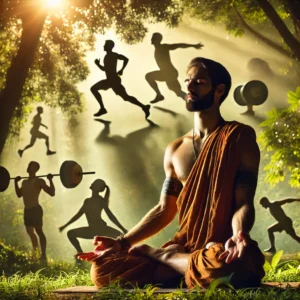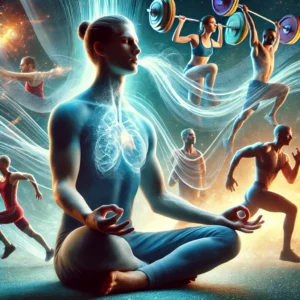
How pranayama improves athletic endurance naturally
Pranayama: How Ancient Breathing Techniques Enhance Sports Performance
Pranayama, the ancient practice of breath control in yoga, has been revered for centuries as a means to enhance physical and mental well-being. In recent years, athletes and sports professionals have started incorporating pranayama into their training regimens to boost endurance, enhance focus, and improve overall performance. This article explores how ancient breathing techniques can provide a competitive edge in modern sports.
The Science Behind Pranayama and Athletic Performance
Pranayama involves conscious regulation of the breath through various techniques, such as Nadi Shodhana (alternate nostril breathing), Bhastrika (bellows breath), and Kapalabhati (skull-shining breath). Scientific research has shown that these techniques positively impact oxygen utilization, lung capacity, and mental resilience—key components of athletic excellence.
- Increased Oxygen Efficiency
Oxygen is the fuel that powers an athlete’s body. Pranayama techniques enhance the efficiency of oxygen exchange in the lungs, leading to improved endurance and reduced fatigue. Slow, deep breathing patterns, such as in Anulom Vilom (alternate nostril breathing), optimize oxygen absorption, making muscles more efficient and resilient during prolonged exertion.
- Enhanced Lung Capacity and Respiratory Strength
Sports require significant lung power, especially in endurance disciplines like running, swimming, and cycling. Pranayama strengthens the diaphragm and intercostal muscles, increasing lung capacity and improving overall respiratory efficiency. Regular practice of Bhastrika pranayama can expand lung function, allowing athletes to perform at higher altitudes or under intense physical stress.
- Improved Focus and Mental Clarity
Athletic performance is as much a mental game as it is a physical one. Practices like Ujjayi (victorious breath) and Bhramari (humming bee breath) enhance concentration, calm the mind, and reduce stress. These techniques are particularly beneficial for high-pressure sports such as tennis, golf, and archery, where mental clarity and composure determine success.
Table of Contents

How pranayama improves athletic endurance naturally
- Better Recovery and Reduced Stress
Intensive training leads to muscle fatigue and stress accumulation. Pranayama stimulates the parasympathetic nervous system, promoting relaxation and faster recovery. Slow breathing techniques like Sama Vritti (equal breathing) lower cortisol levels, reduce inflammation, and aid in quicker muscle repair, enabling athletes to train consistently without burnout.
- Optimized Cardiovascular Health
Cardiovascular endurance is crucial for athletes participating in prolonged, high-intensity sports. Pranayama has been shown to regulate heart rate and blood pressure, ensuring efficient circulation and oxygen delivery to muscles. Techniques like Dirgha (three-part breathing) enhance heart function, reducing the risk of cardiovascular strain and improving stamina.
- Enhanced Nervous System Function
A well-regulated nervous system is essential for coordination, reaction time, and sustained focus. Pranayama techniques like Sudarshan Kriya and Chandra Bhedana (left nostril breathing) regulate the autonomic nervous system, balancing the body’s response to stress and optimizing neuromuscular efficiency. This leads to better reflexes and improved performance in fast-paced sports.
Integrating Pranayama into Sports Training
To maximize benefits, athletes can integrate pranayama into their daily training routines. Here’s a simple guide:
- Pre-Workout: Practice Bhastrika or Kapalabhati to energize the body and prepare the lungs for intense activity.
- During Training: Use rhythmic breathing techniques like Ujjayi to maintain focus and stamina.
- Post-Workout: Perform Nadi Shodhana or Bhramari to promote relaxation and accelerate recovery.
- Before Competition: Engage in deep, slow breathing such as Sama Vritti to reduce pre-game anxiety and enhance concentration.
- For Injury Rehabilitation: Utilize pranayama techniques to support healing by reducing inflammation and enhancing oxygen delivery to injured tissues.

How pranayama improves athletic endurance naturally
Conclusion
Pranayama offers a natural, powerful way to elevate sports performance. By enhancing oxygen efficiency, strengthening lung capacity, improving focus, accelerating recovery, and optimizing cardiovascular and nervous system function, ancient breath control techniques provide a holistic edge to modern athletes. Whether you are a professional competitor or a fitness enthusiast, incorporating pranayama into your routine can help you unlock new levels of physical and mental potential. With consistent practice, these techniques can transform athletic performance, fostering resilience, efficiency, and a deep connection between breath and movement.
FAQs on Pranayama: Unlocking Athletic Excellence Through Ancient Breathing Techniques
- What is Pranayama?
Pranayama is an ancient yogic practice of controlled breathing techniques that enhance physical, mental, and spiritual well-being. It regulates the flow of prana (life energy) to improve overall health and vitality.
- How does Pranayama benefit athletes?
Pranayama provides several benefits to athletes, including:
- Increased lung capacity and oxygen efficiency
- Enhanced endurance and stamina
- Improved mental focus and clarity
- Faster post-workout recovery
- Reduction in stress, anxiety, and fatigue
- Strengthened cardiovascular and respiratory systems
3. Can Pranayama enhance stamina and endurance?
Yes, controlled breathing techniques help optimize oxygen intake and utilization, which leads to increased stamina and endurance. Techniques like Bhastrika and Ujjayi strengthen lung function, allowing athletes to perform at higher intensity levels for longer durations.
- Which Pranayama techniques are best for athletes?
The following techniques are particularly beneficial for athletes:
- Bhastrika (Bellows Breath): Boosts energy levels and oxygen supply.
- Anulom Vilom (Alternate Nostril Breathing): Balances the nervous system and enhances lung function.
- Kapalabhati (Skull Shining Breath): Detoxifies the body and strengthens the diaphragm.
- Ujjayi (Victorious Breath): Improves endurance and calms the nervous system.
- Bhramari (Humming Bee Breath): Reduces stress and sharpens focus.
5. How often should an athlete practice Pranayama?
Athletes should practice Pranayama for at least 10-20 minutes daily, preferably in the morning or before training. Consistent practice leads to long-term improvements in lung function and overall performance.
- Can Pranayama help with post-workout recovery?
Yes, Pranayama helps reduce muscle soreness and speeds up recovery by enhancing blood circulation and oxygen delivery to tissues. Cooling techniques like Sheetali and Sheetkari are especially useful for post-exercise relaxation.
- Does Pranayama improve focus and mental clarity?
Absolutely! Techniques like Anulom Vilom and Bhramari activate the parasympathetic nervous system, reducing stress and increasing concentration, which is crucial for peak performance in sports.
- Is Pranayama suitable for all types of sports?
Yes, Pranayama benefits athletes across all disciplines—whether you’re a runner, swimmer, cyclist, weightlifter, or involved in team sports like football or basketball. It enhances breath control, which is essential in every physical activity.
- Can beginners practice Pranayama?
Yes, beginners can start with simple techniques such as deep belly breathing, Anulom Vilom, and Ujjayi before progressing to advanced practices like Kapalabhati and Bhastrika. Learning from an experienced instructor ensures proper technique and safety.
- Are there any risks associated with Pranayama?
When practiced correctly, Pranayama is safe and highly beneficial. However, incorrect techniques or overexertion may cause dizziness, hyperventilation, or discomfort. People with respiratory or heart conditions should consult a professional before practicing advanced techniques.
- Can Pranayama be combined with other training methods?
Yes, Pranayama complements strength training, cardio workouts, and flexibility exercises. It can be incorporated into warm-ups, cool-downs, or meditation sessions to optimize performance.
- How long does it take to see results from Pranayama?
The benefits of Pranayama can be felt immediately in terms of relaxation and mental clarity. However, for significant improvements in stamina, endurance, and respiratory efficiency, consistent practice over 4-6 weeks is recommended.
Summary
Pranayama: Unlocking Athletic Excellence Through Ancient Breathing Techniques
Pranayama, the ancient practice of breath control rooted in yogic traditions, has long been revered for its profound impact on physical, mental, and spiritual well-being. In recent years, scientific studies and anecdotal evidence have increasingly highlighted its significance in enhancing sports performance. Athletes across various disciplines, from endurance runners to elite weightlifters, have begun integrating pranayama into their training regimens to optimize their respiratory efficiency, improve focus, and accelerate recovery.
Understanding Pranayama and Its Role in Athletics
Pranayama is derived from the Sanskrit words “prana” (life force) and “ayama” (control or extension). It encompasses a range of breathing techniques designed to regulate and deepen breath patterns, influencing the nervous system and physiological functions. Unlike regular breathing, which often remains shallow and unconscious, pranayama techniques involve conscious breath control, allowing athletes to enhance oxygen intake, increase lung capacity, and maintain composure under physical stress.
How Pranayama Enhances Sports Performance
- Improved Oxygen Utilization and Endurance
One of the primary benefits of pranayama is its ability to enhance oxygen exchange and lung efficiency. Techniques like Bhastrika (bellows breath) and Kapalabhati (skull-shining breath) stimulate the diaphragm and strengthen respiratory muscles, allowing for greater oxygen absorption. This results in increased stamina, reduced breathlessness, and improved endurance, especially in high-intensity sports such as running, cycling, and swimming.
- Enhanced Focus and Mental Clarity
Sports performance is not just about physical strength but also mental resilience. Pranayama techniques like Anulom Vilom (alternate nostril breathing) and Bhramari (humming bee breath) activate the parasympathetic nervous system, reducing stress and anxiety while enhancing concentration. Athletes who practice pranayama regularly report heightened awareness, better reaction times, and improved decision-making skills during competitions.
- Faster Recovery and Reduced Fatigue
High-intensity training and prolonged exertion can lead to muscle fatigue and oxidative stress. Deep breathing exercises such as Ujjayi (victorious breath) and Sama Vritti (equal breathing) help regulate the autonomic nervous system, reducing cortisol levels and promoting faster muscle recovery. Enhanced oxygen circulation accelerates tissue repair and reduces inflammation, allowing athletes to train consistently without excessive strain.
- Better Respiratory Control and Reduced Risk of Injuries
Many injuries in sports stem from improper breathing techniques and inefficient oxygen utilization. By incorporating controlled breathing patterns, athletes can optimize their energy expenditure, maintain proper posture, and avoid hyperventilation-related dizziness or muscle cramps. Practices like Moorchha (prolonged exhalation) train the lungs to expand fully, reducing the risk of respiratory ailments that could hinder athletic performance.
- Increased Lung Capacity and CO₂ Tolerance
Pranayama enhances the body’s ability to tolerate carbon dioxide (CO₂), a critical factor in sustaining physical exertion. Techniques such as Kumbhaka (breath retention) train athletes to hold their breath for longer periods, improving CO₂ tolerance and enhancing anaerobic capacity. This is particularly beneficial for sprinters, divers, and martial artists who rely on short bursts of high-energy movements.
Incorporating Pranayama into Athletic Training
To maximize the benefits of pranayama, athletes should adopt a structured practice tailored to their sport and physical condition. Ideally, pranayama should be performed in a calm environment before or after workouts, with an emphasis on controlled, rhythmic breathing. Beginners can start with simple exercises like diaphragmatic breathing and alternate nostril breathing before progressing to advanced techniques such as breath retention and dynamic breathwork.
Conclusion
Pranayama is a powerful tool that bridges the gap between mind, body, and performance in sports. By mastering breath control, athletes can improve endurance, enhance focus, accelerate recovery, and optimize overall efficiency. As more research validates its effectiveness, pranayama is set to become an essential component of sports training, unlocking new dimensions of athletic excellence through the ancient wisdom of breath.
Unlock the Ancient Wisdom of Sanatan Dharma – Join Us on YouTube!
👉 Subscribe now to Prachin Sanatan Dharma and embark on a journey of enlightenment.
Explore timeless teachings, spiritual insights, and cultural richness on our YouTube channel, Prachin Sanatan Dharma. Dive deep into the essence of Sanatan Dharma through captivating videos that inspire and educate.
Related Articles
- Restful Nights: Ayurvedic Remedies and Traditional Indian Practices to Overcome Insomnia and Late-Night Habits
- The Tridevi: Lakshmi, Saraswati, and Parvati – Their Roles and Powers
- “Divine Creatures of Ancient Indian Scriptures: Exploring the Role of Animals in the Vedas, Puranas, and Mahabharata”
- Nature and Spirituality: Exploring the Sacred Essence of the Himalayas, Ganga, and Other Natural Wonders”
- “Reviving the Gurukul System: Relevance and Lessons for Modern Education”
- “Exploring Greek and Indian Mythology: Similarities Between Greek and Indian Mythology “
- “Embracing Sattvic Living: Harmonizing Mind, Body, and Soul Through Food and Lifestyle”
- “Charity and Prosperity: Exploring the Concept of Daan and Its Financial Relevance in Modern Life”
- How to Build an Eco-Friendly Home Inspired by Vastu Shastra
- Comparison of Ancient and Modern Sports: How Traditional Sports Have Influenced Contemporary Games
- “Timeless Lessons from Ancient Tales: Linking Samudra Manthan and Ganga’s Descent to Modern Ecological Challenges”
- “Reviving Sanskrit: How AI is Preserving Ancient Languages for the Future”
- “Mathura: The Sacred Land of Lord Krishna’s Divine Leelas”
- Investing for Future Generations: Lessons from Indian Traditions on Legacy Building and Wealth Preservation
- “Ancient Indian Wisdom: Timeless Lessons for Tackling Today’s Climate Crisis”
- “Artificial Intelligence and Spirituality: Transforming Ancient Practices for the Modern World”
- “Gold and Real Estate in India: Timeless Assets Shaping Financial Strategies”
- Tradition Meets Innovation: The Evolution of Technology in Hindu Rituals
- End-of-World Myths: Exploring Kali Yuga in Hinduism and Ragnarök in Norse Mythology
- Garuda, Pegasus, and Dragons: The Universal Ties of Mythical Beasts Across Cultures
- “Ancient Vimanas: Mythical Flying Machines or Evidence of Advanced Technology?”
- Time Travel in Hindu Mythology: The Fascinating Tales of Kakudmi and King Raivata
- “Divine Feminine Power in Hindu Mythology: The Legends of Durga, Saraswati, and Lakshmi”
- “Divine Beings of Sanatan Dharma: The Spiritual Significance of Sacred Animals in Hinduism”
- “Symbolism in Mythological Art: Unlocking Hidden Meanings in Ancient Temple Carvings”
- “Exploring Technological Advancements in Ancient India and Civilizations: Vimana, Metallurgy, & Water Management systems”
- Unveiling the Mysteries: Ancient Temples of Sanatan Dharma , Mysterious Temples of India
- “The Scientific Knowledge of Sanatan Dharma: Ancient Wisdom Meets Modern Science”
- Ancient Indian Sports and Games: Celebrating a Legacy of Skill, Strength & Strategy”
- “Exploring the Cosmic Link: The Connection Between Astronomy and Vedic Astrology”
- The Power of Sanskrit: Unlocking the Divine Language of the Gods
- “The End of Kaliyuga: A Sanatan Insight into the World’s Final Chapter”
- Explore more articles on Prachin Sanatan Yuga.
How pranayama improves athletic endurance naturally How pranayama improves athletic endurance naturally How pranayama improves athletic endurance naturally How pranayama improves athletic endurance naturally How pranayama improves athletic endurance naturally How pranayama improves athletic endurance naturally How pranayama improves athletic endurance naturally How pranayama improves athletic endurance naturally
How pranayama improves athletic endurance naturally How pranayama improves athletic endurance naturally How pranayama improves athletic endurance naturally How pranayama improves athletic endurance naturally How pranayama improves athletic endurance naturally How pranayama improves athletic endurance naturally How pranayama improves athletic endurance naturally How pranayama improves athletic endurance naturally
How pranayama improves athletic endurance naturally How pranayama improves athletic endurance naturally How pranayama improves athletic endurance naturally How pranayama improves athletic endurance naturally How pranayama improves athletic endurance naturally How pranayama improves athletic endurance naturally How pranayama improves athletic endurance naturally How pranayama improves athletic endurance naturally
How pranayama improves athletic endurance naturally How pranayama improves athletic endurance naturally How pranayama improves athletic endurance naturally How pranayama improves athletic endurance naturally How pranayama improves athletic endurance naturally How pranayama improves athletic endurance naturally How pranayama improves athletic endurance naturally How pranayama improves athletic endurance naturally
Pranayama is a powerful tool that bridges the gap between mind, body, and performance in sports. By mastering breath control, athletes can improve endurance, enhance focus, accelerate recovery, and optimize overall efficiency. As more research validates its effectiveness, pranayama is set to become an essential component of sports training, unlocking new dimensions of athletic excellence through the ancient wisdom of breath.
Pranayama is a powerful tool that bridges the gap between mind, body, and performance in sports. By mastering breath control, athletes can improve endurance, enhance focus, accelerate recovery, and optimize overall efficiency. As more research validates its effectiveness, pranayama is set to become an essential component of sports training, unlocking new dimensions of athletic excellence through the ancient wisdom of breath.
